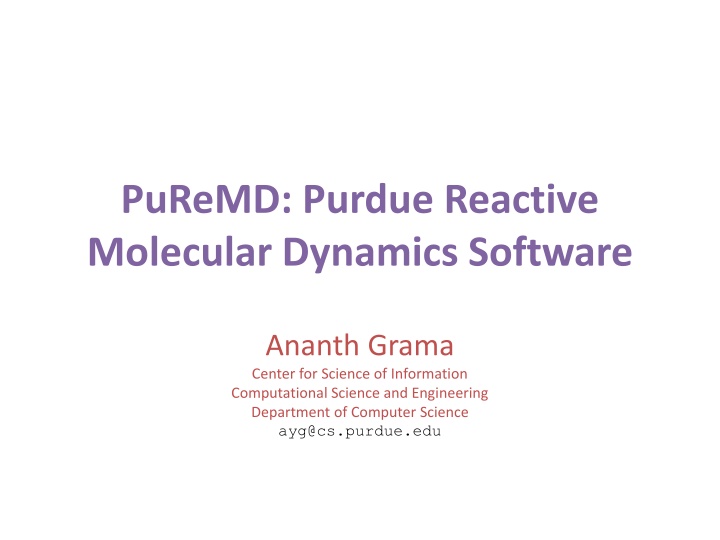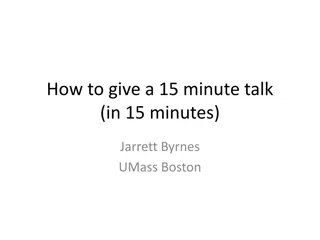
ReaxFF in PuReMD Software for Molecular Dynamics
PuReMD, developed at Purdue University, is a reactive molecular dynamics software focusing on ReaxFF as a classical MD method. This software explores dynamic bonds, charges, and generation of neighbor lists to enhance molecular simulations. It also implements optimizations like elimination of bond order derivative lists for efficient force computations.
Download Presentation

Please find below an Image/Link to download the presentation.
The content on the website is provided AS IS for your information and personal use only. It may not be sold, licensed, or shared on other websites without obtaining consent from the author. If you encounter any issues during the download, it is possible that the publisher has removed the file from their server.
You are allowed to download the files provided on this website for personal or commercial use, subject to the condition that they are used lawfully. All files are the property of their respective owners.
The content on the website is provided AS IS for your information and personal use only. It may not be sold, licensed, or shared on other websites without obtaining consent from the author.
E N D
Presentation Transcript
PuReMD: Purdue Reactive Molecular Dynamics Software Ananth Grama Center for Science of Information Computational Science and Engineering Department of Computer Science ayg@cs.purdue.edu
ReaxFF vs. Classical MD ReaxFF is classical MD in spirit basis: atoms (electron & nuclei) parameterized interactions: from DFT (ab-initio) atomic movements: Newtonian mechanics many common interactions bonds valence angles (a.k.a. 3-body interactions) dihedrals (a.k.a. 4-body interactions) hydrogen bonds van der Waals, Coulomb
ReaxFF vs. Classical MD Static vs. dynamic bonds reactivity: bonds are formed/broken during simulations consequently: dynamic multibody interactions complex formulations of bonded interactions additional bonded interactions multi-body: lone pair & over/under-coordination due to imperfect coord. 3-body: coalition & penalty for special cases like double bonds 4-body: conjugation for special cases Static vs. dynamic charges Charge equilibration -- large sparse linear system (NxN) N = # of atoms updates at every step! Shorter time-steps (femtoseconds vs. tenths of femtoseconds) Result: a more complex and expensive force field
Generation of Neighbors List atom list 3D Neighbors grid atom list: reordered
Neighbors List Optimizations Size of the neighbor grid cell is important rnbrs: neighbors cut-off distance set cell size to half the rnbrs Reordering reduces look-ups significantly neighbors grid No need to check these cells with reordering! Looking for the neighbors of atoms in this box Just need to look inside these cells Atom to cell distance d If d > rnbrs, then no need to look into the cell Verlet lists for delayed re-neighboring
Elimination of Bond Order Derivative Lists BOij: bond order between atoms i and j at the heart of all bonded interactions dBOij/drk: derivative of BOij wrt. atom k non-zero for all k sharing a bond with i or j costly force computations, large memory space needed Analogy Eliminate dBO list delay computation of dBO terms accumulate force related coef. into CdBOij compute dBOij/drk at the end of the step fk += CdBOij x dBOij/drk
Look-up Tables Expensive non-bonded force computations Large number of interactions:rnonb ~ 10A vs. rbond ~ 4-5A but simple, pair-wise interactions Reduce non-bonded force computations create look-up tables cubic spline interpolation: for non-bonded energy & forces Experiment with a 6540 atom bulk water system Significant performance gain, high accuracy
Linear Solver for Charge Equilibration QEq Method: used for equilibrating charges approximation for distributing partial charges solution using Lagrange multipliers yields N = # of atoms H: NxN sparse matrix s & t fictitious charges: used to determine the actual charge qi Too expensive for direct methods space) methods Iterative (Krylov sub-
Basic Solvers for QEq Sample systems bulk water: 6540 atoms, liquid lipid bilayer system: 56,800 atoms, biological system PETN crystal: 48,256 atoms, solid Solvers: CG and GMRES H has heavy diagonal: diagonal pre-conditioning slowly evolving environment : extrapolation from prev. solutions Poor Performance: tolerance level = 10-6 which is fairly satisfactory # of iterations = # of matrix- vector multiplications actual running time in seconds fraction of total computation time due to cache effects much worse at 10-10 tolerance level more pronounced here
ILU-based preconditioning ILU-based pre-conditioners: no fill-in, 10-2 drop tolerance effective (considering only the solve time) bulk water system cache effects are still evident bilayer system no fill-in + threshold: nice scaling with system size ILU factorization is expensive time to compute preconditioner solve time (s) total time (s) system/solver bulk water/ GMRES+ILU 0.50 0.04 0.54 bulk water/ GMRES+diagonal ~0 0.11 0.11
ILU-based preconditioning Observation: can amortize the ILU factorization cost slowly changing simulation environment re-usable pre-conditioners PETN crystal: solid, 1000s of steps! Bulk water: liquid, 10-100s of steps!
Memory Management Compact data-structures n-1 n n-1 n n-1 s data n s data n-1 s data n s data reserved for n-1 reserved for n in CSR format neighbors list Qeq matrix 3-body interactions in modified CSR bonds list hbonds list Dynamic and adaptive lists initially: allocate after estimation at every step: monitor & re-allocate if necessary Low memory foot-print, linear scaling with system size
Validation Hexane (C6H14) Structure Comparison Excellent agreement!
Comparison to MD Methods Comparisons using hexane: systems of various sizes Ab-initio MD: CPMD Classical MD: GROMACS ReaxFF: SerialReax
Comparison with LAMMPS-Reax Time per time-step comparison Qeq solver performance different QEq formulations similar results LAMMPS: CG / no preconditioner Memory foot-print
Parallel Realization: PuReMD Built on the SerialReax platform Excellent per-timestep running time Linear scaling memory footprint Extends its capabilities to large systems, longer time-scales Scalable algorithms and techniques Demonstrated scaling to over 9K cores Parallel Reactive Molecular Dynamics: Numerical Methods and Algorithmic Techniques, Akgulta et al., 2013.
Parallelization: Outer-Shell choose full- shell due to dynamic bonding despite the comm. overhead r r b b full shell half shell r/2 r b b midpoint-shell tower-plate shell
Parallelization: Boundary Interactions rshell= MAX (3xrbond_cut, rhbond_cut, rnonb_cut)
Parallelization: Messaging Performance Performance Comparison: PuReMD with direct vs. staged messaging
PuReMD-GPU Design Initialization neighbor-list, bond-list, hydrogen bond-list and Coefficients of QEq matrix Bonded interactions Bond-order, bond-energy, lone-pair, three-body, four-body and hydrogen-bonds Implementation of Non-bonded interactions Charge Equilibration Coulombs and Van der Waals forces
Neighbor List Generation Each cell with its neighboring cells and neighboring atoms Processing of neighbor list generation
Other Data Structures Iterating over the neighbor list to generate bond/hydrogen-bond/QEq coefficients All the above lists are redundant on GPUs Three kernels, one for each list Redundant traversal of neighbor list by kernels One kernel for generating all the list entries per atom pair
Bonded and Non-bonded Interactions Bonded interactions are computed using one thread per atom Number of bonds per atom typically low (< 10) Bond-list iterated to compute force/energy terms Expensive three-body and four body interactions because of number of bonds involved (three-body list) Hydrogen-bonds use multiple threads per atom (h-bonds per atom usually in 100 s)
Nonbonded Interactions Charge Equilibration One warp (32 threads) per row SpMV, CSR Format GMRES implemented using CUBLAS library Van der Waals and Coulombs interactions Iterate over neighbor lists Multiple thread per atom kernel
PG-PuReMD Multi-node, multi-GPU implementation Problem decomposition 3D Domain decomposition with wrap around links for periodic boundaries (Torus) Outer shell selection PG-PuReMD uses full-shell rshell = max(3 x rbond, rhbond, rnonb)
Experimental Results LBNL s GPU Clusters: 50 node GPU cluster interconnected with QDR Infinitiband switch GPU Node: 2 Intel 5530 2.4 GHz QPI Quadcore Nehalem processors (8 cores/node), 24 GB RAM and Tesla C2050 Fermi GPUs with 3GB global memory Single CPU : Intel Xeon E5606, 2.13 GHz and 24 GB RAM
Experimental Setup CUDA 5.0 development environment -arch=sm 20 -funroll-loops O3 compiler options GCC 4.6 compiler, MPICH2 openmpi Cuda object files are linked with openmpi to produce the final executable 10-6 Qeq tolerance, 0.25 fs time step and NVE ensemble
Conclusions PuReMD is available for public download at https://www.cs.purdue.edu/puremd Thank You!






















